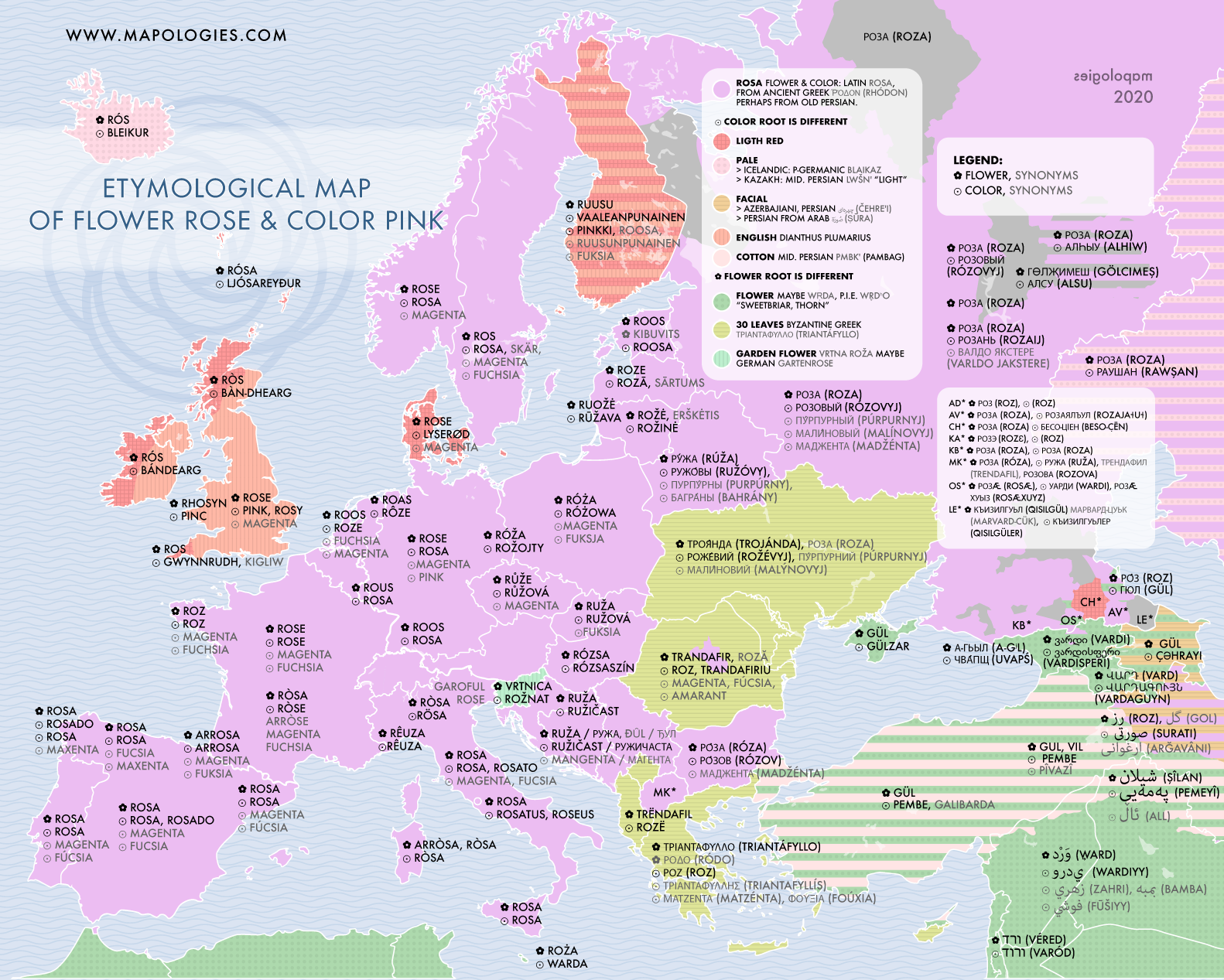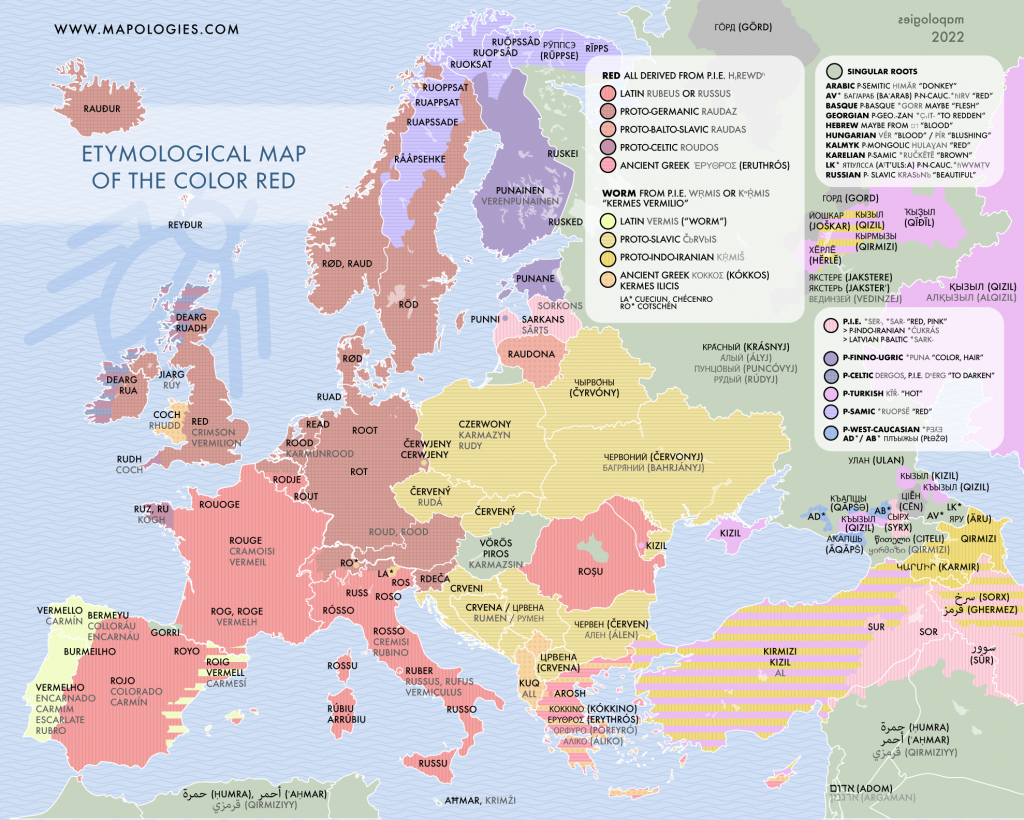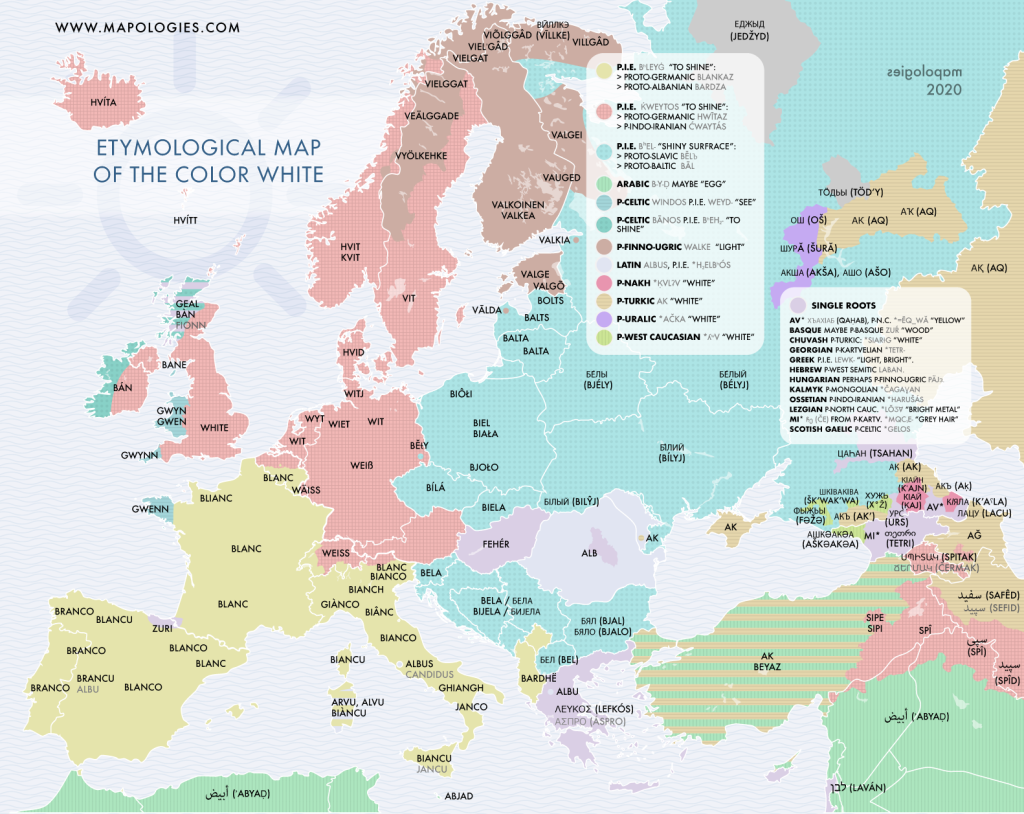Color’s etymology

Languages and colors share a fascinating connection that transcends borders and cultures. Etymologically speaking, the word “color” in different languages can be traced back to common origins. For instance, the Latin language has left its mark on numerous modern tongues. In English, we use the word “colour” or “color” (same as in Spanish) which can be traced back to the Latin term “color”. In other languages too but with a great variety of spellings and pronunciations: French “couleur”, Portuguese “cor” or Italian “colore”.
So the last shall be first
Blue(s)

The name blue is one of the most interesting colors because according to researchers it was one of the last ones to be differentiated in our languages. It used to be black or just a dark red and the light ones grey or green. In other continents, Japanese for example, until recently did not even distinguish green from blue, 青 (ao). On the other hand, some languages, Russian among them, distinguish between light blue and dark blue, with two completely different words: голубо́й (golubój “pigeon” color) and си́ний (sínij). That said, let’s keep in mind that other cultures or past civilizations might lack interest in the cold palette, but it does not mean they lacked the ability to see blue colors (vision is biological, while perception is culturally determined).
The Oriental color
The story of the word blue is the story of the hardship to extract the pigments and dyes. Many languages around the Mediterranean Sea named it after lapis lazuli (literally, stone blue), originally a Persian name لاژورد (lâžward). It is a mineral that was extracted from a single mountain in the far lands of Afghanistan. Bringing this precious material across two vast oceans gave birth to an exotic name in Latin: ultramarine (meaning obviously “beyond the sea”). The mineral was imported to Egypt across the deserts since Antiquity, as pigment however it took a while, almost 7000 years. The first ones arrived in Venice.
If you were a poor artist, without the support of the Church, a more affordable option was azurite. It was very often confused with lapis lazuli, and it is not surprising, since both words share the exact same aforementioned root. The results over time were not comparable, though. Before the Greeks called it κυανός (Kuanaos), from this root we got modern cyan blue, some people say it might be also a dye from the flower Centaurea cyanus.





The Barbaric color
Along with cornflower, other dyes extracted from plants were also used from at least the Neolithic. In Europe, people cropped woad, then crushed it and mixed it with urine. It is been discussed for a long time if “blew” was the color used by the Britanni to cover their skin. Julius Cesar used glastos (glass-like) to describe it. The Gaulish loanword glastu was also used. On the map, you can see that it is still used in some Celtic languages.
In Asia existed a similar plant, indigo (from Portuguese “Indian” but it was known before already as Ἰνδικόν, indikón). A true commercial war exploded when some people thought it would be a good idea to import indigo because it was cheaper and more intense than woad. The European traditional woad industry was endangered, and eventually indigo won. It did not last long: In 1706 Diesbach created in Berlin the first synthetic (and cheap) blue and it was named Prussian blue (aka Parisian blue, why? you ask me).
The flowers’ colors
Violet

Probably there is not a color so connected with flora as this color. Usually called violet, after viola odorata, the sweet violet, or mauve, a French word for mallows, malva sylvestris. In some languages, lila o lilas like the flowers of lilac, syringa vulgaris, which is originally from Persian (لیلک, līlak). A few languages exist the color mulberry (morus nigra), such as Spanish morado, or the color jasmine fruit (jasminum officinale) in the Caucasus.




Other words are, for example, Ancient Greek ἴον (íon). In 1813 when Joseph Louis Gay-Lussac wanted to name a new element which is violet in gas and liquid state, he used ἰώδης “violet-colored”. Also from Ancient Greek comes πορφύρα (porphúra) “purple fish”. The story of purple took place in Tyre, nowadays Lebanon, where the Phoenicians started a lucrative business: collecting thousands of small sea snails (Murex snail) to extract a beautiful reddish dye. It was such an expensive process that only a few people could afford to buy it. Then purple became a synonym of royalty, kings, and emperors. Recently, the Women’s suffrage movement choose purple, along with the other two colors, to represent them, and decades later the feminists continue this tradition.
Rose

What was first, the color or the flower? Roses are one of the oldest flowers cultivated in Asia. The words in Arabic, Persian, and Turkish seem different but they originated from some Iranian language (possibly from the root wrd) the same as rhódon, which was the name used by Ancient Greek, who introduced them to Europe. There they were associated with Aphrodite, the goddess of Love. Theophrastus called them kynosbatos, the wild roses, and rhódon, the cultivated ones. Latin took the second word and became rosa. After the fall of Rome, the cultivation decreased. Later, in the Middle Ages, the Crusaders brought them back and spread them all over Europe by growing gardens in monasteries as an offering to the Virgin Mary. Rosary.
The multi-petaled flower: Only a few Eastern languages have a completely different word that is not derived from the archaic word. The languages that are colored yellow took it from the Byzantine Greek τριαντάφυλλον (triantáphullon), which means thirty petals.
Not only roses are pink: The color pink was introduced in the vocabulary late, like orange and violet. In many languages, it was taken from the French word rose, which appeared around the 12th century. The color in Welsh and English, pink, is named after the flower Dianthus plumarius. The flower might be named pinks because of the pinked edge (like a zig-zag). It is not the only language that has a different root, instead of rose or pink, they use “light red”. It is the case of Danish, Gaelic, and Finnish. In Icelandic bleikur (cognate of English bleak) used to mean “pale” but nowadays means pink. Persian rowšan means also pale but in Kazah became the word for rossy.


Fruits’ colors:
Orange

Orange is also a quite recent addition to the list of basic colors. In English one of the earliest appearances was around 1500. Half a millennium for a color is nothing. Before you could say ġeolurēad (yellow-red). Orange was named after the fruit and it made a long trip: crossing the Channel from French Pome d’orange (borrowed later by some Slavic languages), Italian arancia and then crossing the Mediterranean from the Arabic نارنج (nāranj) across the desert from Persian نارنگ (naarang) up to India (What does not come from there?) in Sanskrit नारङ्ग (nāraṅga).



However, not all languages have the same word for the fruit. In the north, many Germanic and Slavic languages borrowed maybe the Dutch word Applesien (Apple from China) for the fruit but not for the color. This fruit was known in Europe thanks to the Arabs around the 10th century when they introduced the bitter variety, citrus aurantium. Some languages in the South named the fruit “Portuguese”, that is how it was called in Venice, Portocalle, in the 15th century, when the Lusitanian sailors brought, probably from Sri Lanka, sweet oranges (Citrus sinensis).
Just a few languages have a particular word for color. Brandgul in Swedish, and Celtic languages use the old solution, mentioned before, a color between red and yellow.
Brown

Another color frequently associated with fruits is brown. Romance languages have chestnut (Castanea sativa): Either from Byzantine Greek μάραον (máraon) or from Ancient Greek κᾰ́στᾰνᾰ (kástana). Technically not a fruit, coffee is the seed of the Coffea plant, but also the term for brown in many southern languages: Spanish, Arabic, and most languages from the Balkans and the Caucasus. In the North, the situation is more complex and rich. Metals like bronze, in Polish, and copper in Serbo-Croat, a special mention to Slovene rjav, originally meant rusty. In Eastern Slavic languages, the most common word is cinnamon, the curly bark of Cinnamomum. Like other spices, people appreciated in the Antiquity.
As we have said before brown was historically a secondary color, the word appeared later, for that reason, in some languages, it is still connected to other primary colors: in Lithuanian and Finnish with red, and in Breton and Cornish with yellow. That is not always the case. Germanic brunaz was sucessful and many languages adopted it, it came possibly from P.I.E. *bʰerH “brown”. That’s a very old one! Similarly, Proto-Slavic gnědъ, and Proto-Turkic *koŋur origins are dark like an espresso.
The ancient triad
It is believed that during ancient times there was no concept of color. Instead, we find in the oldest records at least three categories: light (white), dark (black), and red. That is why some historians say that is the oldest “color”, in the modern sense, a certain hue and not just brightness. The reconstruction of a common Indo-European language indicated that the word “red” shared the root h₁rewdʰ- with many west European languages (in the map the red ones):
Red

To understand the etymologies of the color red is necessary to understand the history of its production. The pigments from minerals were the earliest ever used. Like hematite (Fe2O3) or clays, with a high concentration of iron oxides. Miniature, usually believed to mean small (mini), surprisingly comes from the Latin minium, another name for red lead (Oxide of lead, Pb3O4). Mercury sulfide (HgS) is known as Cinnabar, which comes from Ancient Greek κιννάβᾰρῐ (kinnábari), in another metal named the color for centuries.
The vegetal dyes were extracted from madder, rubia tinctorum, a plant that belongs to the genus name rubia, this word derives from the Latin ruber “red”. In English, the words ruby, the gem, and rouge, in make-up, belong to this same root. In Spanish, it exists also rubio “blond”. Finnish and Estonia are the other way around: the color red comes from the word blond (puna).
The buggy colors:
The dyes from animals gave their name to the color red in many languages (in the map, the yellow-colored languages). In the Neolithic, people started already to use the dye made by smashing the bodies of the Armenian cochineal (Porphyrophora hamelii) or Kermes (Kermes vermilio). In English, the word crimson comes from the Sanskrit word कृमिज (kṛmija) “produced by worms or insects”. This root existed also in Latin: vermiculus “little worm”, Portuguese preserves it, vermelho, but in English, vermilion. In some Slavic languages, the words worm and red are still related. For example, in Czech červ anf červený. This is becuase of the old Proto-Balto-Slavic, kírmis.
Very similar, and often confused, is the dye from the females of Dactylopius coccus, an insect that lives in the cacti in North America and was widely used by Aztecs and Mayas. The last ones called them nōcheztli but the Spanish conquistadores probably thought they were very similar to pill bugs or roly-polies (Armadillidium vulgare), so they renamed them “cochinilla“. English borrowed this word later: cochineal. The insect name in Spanish comes from Ancient Greeks κόκκος (kókkos) “grain or seed” because of their round shape, very original. A curiosity: it is the same root of the round-shaped bacteriae, coccus, but is NOT related to coconut. Ops!




Other rednesses:
Hungarian is one of the few languages that has two terms: the second piros is linked to blushing (pír). The first one vörös is connected to blood (from vér). Like in Hebrew adom or in Ancient Greek αἱματίτης “Hematite” (haima+títēs, blood+stone), the mineral we spoke about above. What does Science say about this topic? Well, scientists say that red is the “hottest” color (625 and 740 nanometers). Turkic languages can agree that their modern words emerged from the ancient kï̄ŕ- “to be hot”.
Black

It is the color of the dark, the night, the unknown. But judged by this etymological map it is quite predictable. At first look only. Romance languages inherited the word from Latin nigrum (a word related to night), Germanic languages from a Proto-Germanic word swartaz, and Slavic languages did the same with its ancient common predecessor Proto-Slavic: čьrnъ. No surprises. No shared roots.
But a closer look reveals some darker parts, in this map actually grey zones. The number of languages with a unique word that is unrelated is very high. More than twelve. Have a look at English black. No other Germanic language uses it, with that sense, of course. In the extreme of the map, Portuguese (along with other West Iberian languages) prefers preto to negro. Latvian and Lithuanian also have peculiar terms. Latvian melns is akin to Ancient Greek μέλᾱς (mélās) (same root as in English melanin) but modern Greek favors μαύρος (mávros).
White

Is this map a language family map? Almost. Similar to the etymology map of the color black, which has many unrelated roots, the etymology map of the color white matches in general the distribution of family groups. Germanic languages stick to hwītaz. Turkic languages use universally ak (and Persian). Slavic and Baltic languages share the same Proto-Indo-European root: bʰel.
But again, let’s have a closer look. Not all romance languages use the same word: Many romance languages (and Albanian) chose a Germanic word, blank, but Romanian maintains the original from Latin, albus.
One interesting case: Mari, Erzyan, and Moksha are neighbors of Chuvash and they all share the same root, despite that the last belongs to a different language family.
The Twin colors
Yellow

Most of the words in European languages come from The Proto-Indo-European root *ghel- “to shine“. An important exception is the Romance languages.
In the West, yellow comes from the Latin amarus, a word that meant, among other meanings, bitter. Some theories say that the relation between the color yellow and the taste bitter is based on the body fluid bile or the effects of liver diseases on the skin. In Georgian, this metaphor might be present as well but it is not confirmed. On the other hand, the rest of the Romance languages derived from Latin galbinus. Another mysterious word. It is often said that it might be from the plant galbanum (Ferula gummosa). In Persian and Kurdish, the color metaphor is with the metal gold.
The third big group is the Turkic languages (and Hungarian), they all derived from Proto-Turkic *siar(ï). This group is related to a bigger group of Asian languages like Proto-Mongolic *sïra “yellow” and Proto-Japonic *siro “white”.
A lot of languages have singular roots, not related to other languages, which refer to different metaphors. Prominent examples are Catalan groc, from Ancient Greek κρόκος (krókos) “safron”; and modern Greek, κίτρινος (kítrinos), from Koine Greek κίτρινος (kítrinos) “citron tree”.
Green

The Proto-Indo-European root *ghel- “to shine” is the origin of green in the Slavic languages, just the same root as yellow. It is very likely that originally there was little need to differentiate them. In fact, The Albanian language case is exemplary, it flips the Latin roots: while gjielbër, from Latin galbinus “yellow“, means green; verdhë means yellow, from viridis “green”.
This root, viridis, comes from a P.I.E. root *weys- meaning “increase”. A similar meaning, although not related, to Proto-Germanic *grōniz from the P.I.E. root *gʰreh₁- ” to grow”. Surprisingly, a root shared with the color grey. Still for most languages, green is the color of vegetation and the ideas of growth and propagation. Similarly, the Turkic root for green, jal, is present in the name of many herbs and types of grass. This metaphor appears also in Estonian and Kalmyk.
On the opposite side, for the Uralic languages, green was borrowed from Proto-Indo-Iranian *wišás “poison, bile”. Again another example of the linguistic connection between green and yellow.
Gray

When we think of the color grey people mention ashes, some metals like iron and silver, cement or concrete, and the color of the hair (Some languages have a distinct word for grey fur or grey hair, in the map appears between squared brackets). But not vegetation. It is a color to describe dead, cold, and artificial things, the opposite of green basically. And still, there are etymologically cognates.
Most languages from West Europe had taken the word grey from Proto-Germanic *grēwaz. The origin of this word might be Proto-Indo-European *ǵʰreh₁- “to green, to grow”. This is mind-blowing.
Grey is a mysterious color. It is ambiguous. It is not black or white. But unlike other colors can take almost any shade and hue. Blues are also very rich, you might say that a blue is lighter or darker, greenish or reddish. But not yellowish. On the other hand, grey can be reddish, yellowish, blueish, or greenish. For this reason maybe grey evolved slowly from some shades of green.
It is quite obvious why some languages call grey “ashes color” like Portuguese cinzento, Albanian hirtë, Sardinian cinixàli, Arab رمادي (ramādiyy), Armenian մոխրագույն (moxraguyn) or Georgian ნაცრისფერი (nacrisperi).
The geographic reason might intervene as well, thus Baltic languages and Finish too, have words for grey derived from Proto-Indo-European *ḱerH- “hoarfrost, grey”. Latvian and Lithuanian have other words too. Latvian word pelēks is a very interesting case: It derives from pele “mouse“. But it is possible too that it came from the adjective pels “mouldy“.
Finally, some languages look up at the sky: In Avar grey is цІахІилаб (ⱬaћilab), but a synonym can be накІкІукьераб (naⱪⱪuꝗerab), literally “cloud + color”.




[…] mappe interessanti sono quella sui brindisi, quella sui colori e […]